The Victorian Photographic Society That Tried to Preserve ‘Old London’
In capturing images of doomed buildings, they documented the city they thought they were losing.
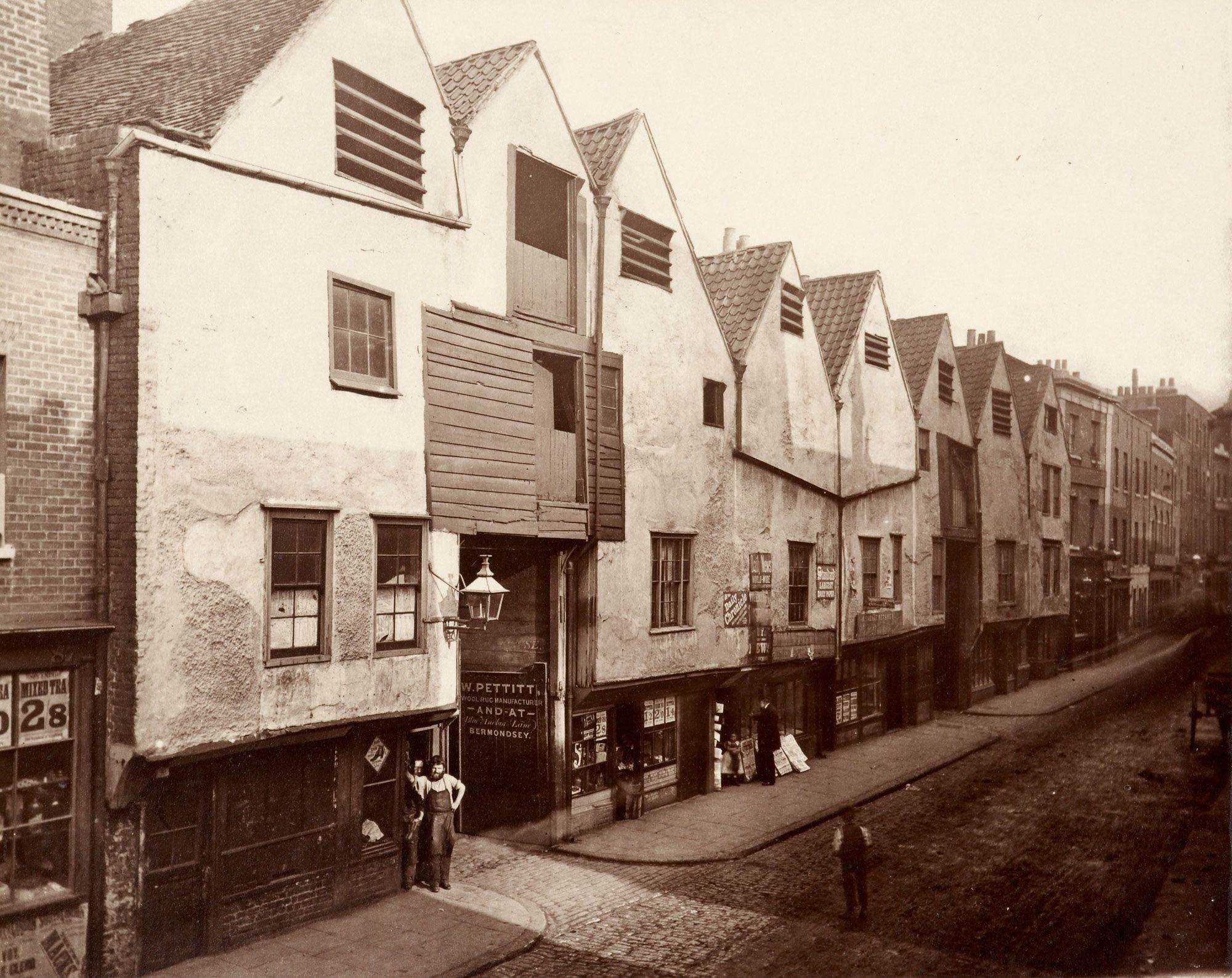
In 1875, Alfred Marks learned he was about to lose an old friend. The Oxford Arms, north of St. Paul’s Cathedral, had spent centuries as a coaching inn, a place for travelers to stay while heading into or out of London. Then it had become a tenement house. It was, as Marks later wrote, “an excellent example of the galleried Inns”—rooming houses with interior balconies, so that visitors could take in stage shows and other entertainment—“now becoming every year more scarce.” Now, it was to be knocked down in order to make room for the expanding grounds of the Old Bailey courts next door.
It’s a feeling familiar to contemporary city-dwellers: a beloved building bites the dust. Who hasn’t walked past a nearby edifice, learned that it’s doomed by construction, and mourned their changing environs? The next step is often to snap a photo, for whenever that shiny new condo takes its place.
Back in the 1870s, Marks had a similar instinct. He lacked an iPhone, but his era provided its own resources: commercial photographers, long-lasting carbon-based ink, and—most importantly—a city full of potential subjects, structures that might soon suffer the same fate as the Oxford Arms.
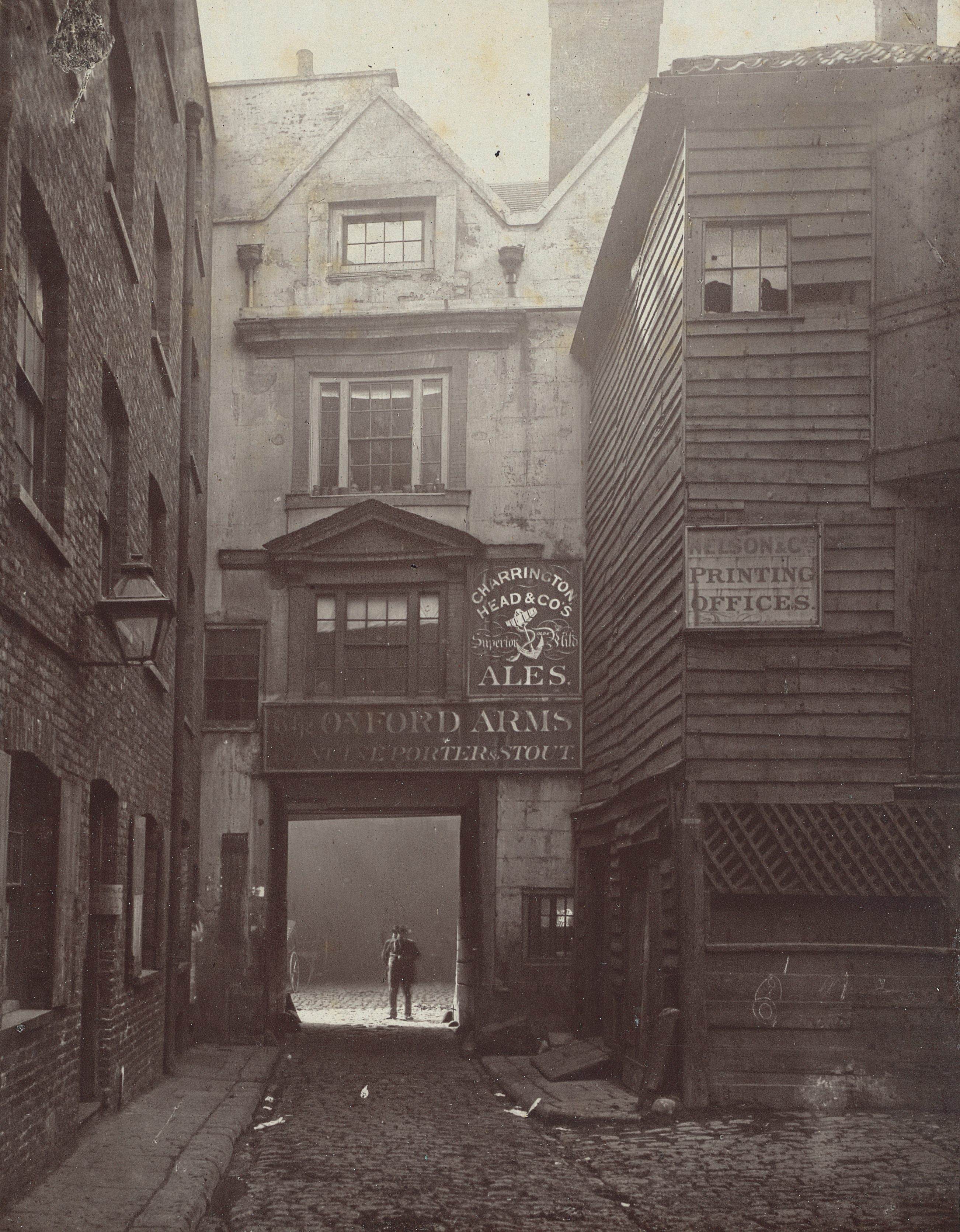
Over the next 11 years, as the founder and secretary of the Society for Photographing Relics of Old London, Marks orchestrated the photographic preservation of dozens of buildings, including churches, inns, schools, hospitals, and houses. The choices he made help tell the story of preservation in London, and throw our own practices into relief.
Everything sped up in the Victorian era, including the pace of change. The Industrial Revolution brought new technologies and transportation, along with new philosophies, priorities, and even new ways of thinking about time and space. As the geographer Kenneth Foote writes in a paper about the Society, many Londoners at the time “were held in tension between excitement about progress, and alarm over change at the expense of long-lived traditions.”
Foote started writing about the Society in the early 1980s, when he was living in Austin, Texas. He noticed that when his neighbors bemoaned changes happening in their own city, their wistfulness tended to lodge itself in particular buildings. “Every time I talked with people who had been there for a long time, they’d say, ‘Austin isn’t what it used to be! Since they closed the Armadillo World Headquarters, it just hasn’t been the same.’” Foote says. “There was a sense of nostalgia for this great past that was getting lost from the cityscape.” The same was true in Victorian London, Foote explains: People may have loved the new locomotives, but some—like Marks—also missed the coaches, and the coaching inns.

Marks was well-positioned for such nostalgia. He was an antiquarian scholar, and his father had been a coach builder, which may explain his particular attachment to the Oxford Arms. When he heard the building was to be demolished, Marks raised money from a few friends. He hired Alfred and John Bool, a father-son photography team best known for their landscapes, to take photos of the Arms. He then started looking for others who felt the same way he did, and might want to buy the work. “Should any readers … interested in London antiquities desire to join the subscription, I shall be happy to hear from them,” he announced in the London Times.
The Society launched “one of the first efforts” to use photography to document endangered buildings, says Foote. It was also special in that its photos were meant to be collected, like fine art. All were printed in carbon—an expensive process—to ensure they wouldn’t fade.
The first photograph set, released in 1875, consisted of six different views of the Oxford Arms, including the entrance, the yard, and the galleries. The second, which came a year later, focused on old houses and inns near Wynch Street and Drury Lane. In 1878, Marks doubled his production speed, going from six photos per year to 12. Three years later, he began writing up short texts about the buildings, printing them out, and issuing them to subscribers along with the photographs.

“The project became much bigger than he originally intended,” says Chitra Ramalingam, the Assistant Curator of Photography at the Yale Center for British Art, which exhibited SPROL’s photographs in 2016. Still, Marks ran the show, choosing which buildings to focus on, and particular details to highlight. (Despite its name, there’s no evidence the Society ever met up in real life, or had any true members besides Marks.)
While later historic preservation projects were more encyclopedic, Marks put his energy specifically towards buildings that he thought “served as important records of [England’s] national character,” Ramalingam says. His texts are filled with references to royalty and famous people, along with literature, legends, and nursery rhymes. The poet Ben Jonson, he writes, may have laid some of the bricks at Lincoln’s Inn—the subject of photo 12. A mansion on Leadenhall Street, depicted in photo 20, once had “a grand staircase,” cedar-paneled floors, and “decorations … of a very sumptuous character.”
Marks gave such scrupulous instructions to the Bools—as well as to Henry and Thomas James Dixon, who he hired to replace them in 1879— that each photograph was effectively “a collaboration between Marks and the photographer,” says Ramalingam. Some of his priorities led to unorthodox images. One of Ramalingam’s favorites from the series is Number 17, which depicts a church called St. Bartholomew the Great.

“It’s actually of an alley behind the church,” she says. “The photographer has climbed up to what must have been a really awkward perch, and is taking [the photo] looking down. You see this view of intersecting planes—this series of angles that slices through the alley. It looks incredibly modern.”
Equally important, Ramalingam points out, is what Marks chose not to highlight. The Society called these buildings “relics,” and the photographs treat them as such. Humans are rarely present, and those that are there were almost certainly posed, to provide scale. (The photographs’ long exposures meant that “you wouldn’t be able to get a candid shot of someone, a kid outside a doorway, if you didn’t say, ‘Hey kid, stand still,’” Ramalingam says.)
This choice foregrounds certain aspects of history while eliding others. The Oxford Arms, for example, had been a tenement for about seven years when it was slated for demolition. Even as the Society came to photograph the building, its inhabitants were being moved out. Marks may have been losing a favorite structure, but they were losing a home.
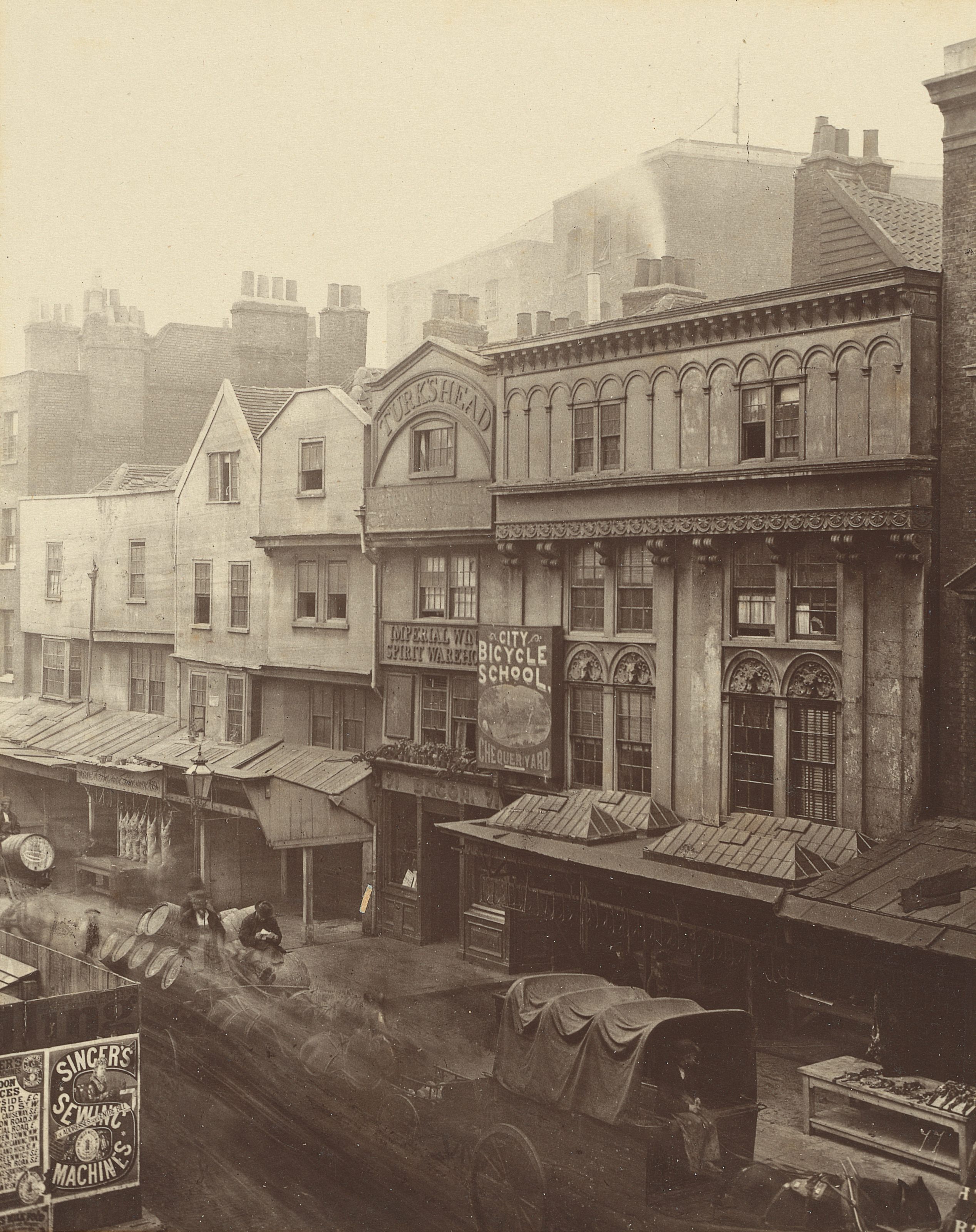
Although there was a growing tradition of documentary photography in the country at the time—including whole books focused on the lives of impoverished Londoners—“that is definitely not what is happening in this series,” says Ramalingam. “[Marks] doesn’t want these buildings photographed as slums.” In the text he later wrote about the Arms, he barely mentioned this stage of its life. Instead, he focused on a particular Earl that used to visit, and how difficult it would have been to get a nine-horse coach around the narrow street corner.
Still, look closely at the photographs, and you see hints of life: laundry hanging from the banisters of the Arms, empty plant pots on a windowsill. “For a viewer now, those are some of the most interesting details in the picture,” Ramalingam says. “But Marks seems to want you to look right past them.”
Marks disbanded his Society in 1886, 11 years after he’d started it. By this point, he had released 120 photographs, in 12 sets, and had enjoyed a certain amount of commercial success, selling over 100 subscriptions. “It is not suggested that the subject has been exhausted,” he wrote at the time, “but it is hoped that the work may be regarded as fairly complete within the lines at first marked out.”

Although many of his subjects were gone, some had gained more permanent protection. “From the 1870s onward, [preservation] laws became tighter and tighter,” says Foote. In 1894, the reformer Charles Robert Ashbee embarked on the first Survey of London, aiming to achieve a comprehensive architectural account of the city. By the turn of the century, Foote writes, “it was clear that the principles of conservation were well formed.”
In 1985, while working on his own article, Foote walked around checking on the buildings in the photo series. “Around half of them were gone,” he says, but several dozen remained—and remain still—including Lincoln’s Inn, St. Bartholomew the Great, and Great St. Helens, pictured above.
“Some of the sites were very striking,” he says. “It’s almost as though a person could step into that same scene and take a photograph today.” Just as Marks would have liked it.


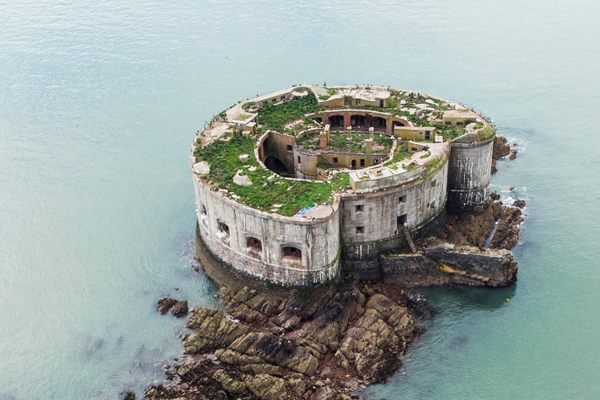

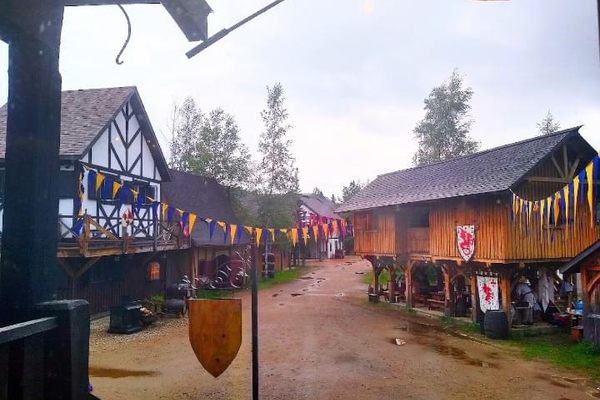
















Follow us on Twitter to get the latest on the world's hidden wonders.
Like us on Facebook to get the latest on the world's hidden wonders.
Follow us on Twitter Like us on Facebook